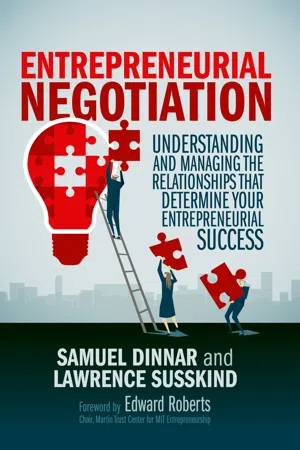
Entrepreneurial Negotiation
Understanding and Managing the Relationships that Determine Your Entrepreneurial Success
- English
- ePUB (mobile friendly)
- Available on iOS & Android
Entrepreneurial Negotiation
Understanding and Managing the Relationships that Determine Your Entrepreneurial Success
About this book
The great majority of startups fail, and most entrepreneurs who have succeeded have had to bounce back from serious mistakes. Entrepreneurs fumble key interactions because they don't know how to handle the negotiation challenges that almost always arise. They mistakenly believe that deals are about money when they are much more complicated than that.
This book presents entrepreneurship as a series of interactions between founders, partners, potential partners, investors and others at various stages of the entrepreneurial process - from seed to exit. There are plenty of authors offering 'tips' on how to succeed as an entrepreneur, but no one else scrutinizes the negotiation mistakes that successful entrepreneurs talk about with the authors.
As Dinnar and Susskind show, learning to handle emotions, manage uncertainty, cope with technical complexity and build long-term relationships are equally or even more important. This book spotlights eight big mistakes that entrepreneurs often make and shows how most can be prevented with some forethought. It includes interviews with high-profile entrepreneurs about their own mistakes. It also covers gender biases, cultural challenges, and when to employ agents to negotiate on your behalf.
Aspiring and experienced entrepreneurs should pay attention to the negotiation errors that even the most successful entrepreneurs commonly make.
Frequently asked questions
- Essential is ideal for learners and professionals who enjoy exploring a wide range of subjects. Access the Essential Library with 800,000+ trusted titles and best-sellers across business, personal growth, and the humanities. Includes unlimited reading time and Standard Read Aloud voice.
- Complete: Perfect for advanced learners and researchers needing full, unrestricted access. Unlock 1.4M+ books across hundreds of subjects, including academic and specialized titles. The Complete Plan also includes advanced features like Premium Read Aloud and Research Assistant.
Please note we cannot support devices running on iOS 13 and Android 7 or earlier. Learn more about using the app.
Information
1. Entrepreneurship: The Good, the Bad, and the Terrible
Keywords
Co-foundersAngel investorsTerm sheetVenture capitalists (VCs)Start-up relationshipsEntrepreneurs emotionsTable of contents
- Cover
- Front Matter
- 1. Entrepreneurship: The Good, the Bad, and the Terrible
- 2. The Entrepreneurial World
- 3. When Entrepreneurs Negotiate
- 4. Real Entrepreneurs Describe Their Mistakes
- 5. The Entrepreneurial Galaxy Reimagined: Prevent, Detect, and Respond to Your Mistakes
- 6. Know Your Entrepreneurial Self
- Back Matter